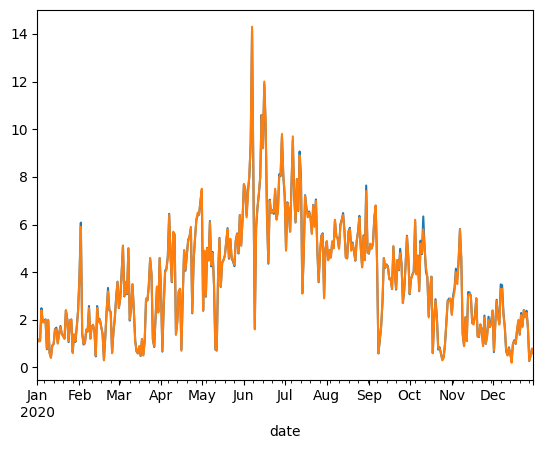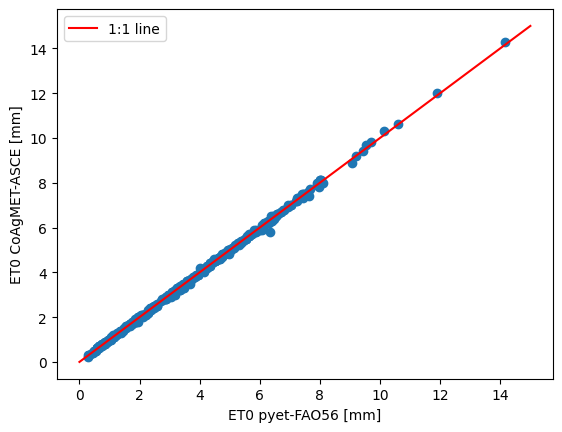Potential Evapotranspiration from CoAgMET data#
M. Vremec, University of Graz, 2021
In this notebook it is shown how to compute (reference) evapotranspiration (\(ET_0\)) from meteorological data observed by the Colorado State University (CoAgMET) at Holyoke in Colorado, USA. The notebook also includes a comparison between \(ET_0\) estimated using pyet (FAO56) and \(ET_0\) available from CoAgMET. According to CoAgMET documentation, the provided reference evapotranspiration is estimated using ASCE reference evapotranspiration for short reference grass (Wright, 2000), which corresponds to the FAO-56 method used with pyet.
Source: https://coagmet.colostate.edu/station/selector
import numpy as np
import pandas as pd
import matplotlib.pyplot as plt
import pyet as pyet
pyet.show_versions()
Python version: 3.11.6 (main, Feb 1 2024, 16:47:41) [GCC 11.4.0]
Numpy version: 1.26.4
Pandas version: 2.2.1
xarray version: 2024.2.0
Pyet version: 1.3.2
1. Load CoAgMET Data#
data = pd.read_csv("data/example_4/et_coagmet.txt", parse_dates=True, index_col="date")
data
| name | tavg | tmax | tmin | rhmax | rhmin | solar | windrun | et_asce | et_pk | et_asce0 | |
|---|---|---|---|---|---|---|---|---|---|---|---|
| date | |||||||||||
| 2020-01-01 | hyk02 | -0.8 | 9.4 | -8.9 | 0.929 | 0.470 | 63.1 | 203.1 | 1.9 | 1.9 | 1.2 |
| 2020-01-02 | hyk02 | 0.8 | 7.2 | -4.2 | 0.902 | 0.568 | 107.4 | 314.7 | 1.7 | 1.7 | 1.1 |
| 2020-01-03 | hyk02 | -0.4 | 5.0 | -4.7 | 0.855 | 0.448 | 76.2 | 239.6 | 1.7 | 1.3 | 1.1 |
| 2020-01-04 | hyk02 | 4.1 | 16.1 | -4.8 | 0.893 | 0.224 | 97.6 | 253.7 | 4.0 | 1.7 | 2.4 |
| 2020-01-05 | hyk02 | 0.5 | 8.2 | -6.9 | 0.820 | 0.232 | 102.3 | 312.2 | 3.1 | 1.9 | 1.9 |
| ... | ... | ... | ... | ... | ... | ... | ... | ... | ... | ... | ... |
| 2020-12-27 | hyk02 | 2.2 | 8.9 | -6.2 | 0.967 | 0.318 | 98.6 | 324.5 | 2.8 | 1.6 | 1.7 |
| 2020-12-28 | hyk02 | -4.0 | 0.0 | -10.1 | 0.994 | 0.878 | 26.2 | 248.3 | 0.4 | 0.6 | 0.3 |
| 2020-12-29 | hyk02 | -4.7 | -1.1 | -10.8 | 0.983 | 0.737 | 55.6 | 441.7 | 0.8 | 0.6 | 0.5 |
| 2020-12-30 | hyk02 | -8.4 | 2.2 | -14.6 | 0.939 | 0.489 | 111.5 | 197.9 | 1.2 | 1.0 | 0.8 |
| 2020-12-31 | hyk02 | -6.3 | 3.4 | -15.3 | 0.929 | 0.459 | 109.0 | 99.9 | 0.9 | 0.6 | 0.6 |
366 rows × 11 columns
et0_coagmet = data["et_asce0"]
meteo = pd.DataFrame({"tmean":data["tavg"],
"tmax":data["tmax"],
"tmin":data["tmin"],
"rhmax":data["rhmax"]*100,
"rhmin":data["rhmin"]*100,
"u2":data["windrun"]*1000/86400,
"rs":data["solar"]*86400/1000000})
tmean, tmax, tmin, rhmax, rhmin, wind, rs = [meteo[col] for col in meteo.columns]
lat = 40.49 * np.pi / 180
2. Comparison: pyet FAO56 vs CoAgMET ASCE#
et0_fao56 = pyet.pm_fao56(tmean, wind, rs=rs, elevation=1138, lat=lat,
tmax=tmax, tmin=tmin, rhmax=rhmax, rhmin=rhmin)
et0_fao56.plot()
et0_coagmet.plot();

3. Plot the results#
We now plot the evaporation time series against each other to see how these compare.
plt.scatter(et0_fao56, et0_coagmet)
plt.plot([0,15],[0,15], color="red", label="1:1 line")
plt.legend()
plt.xlabel("ET0 pyet-FAO56 [mm]")
plt.ylabel("ET0 CoAgMET-ASCE [mm]");

